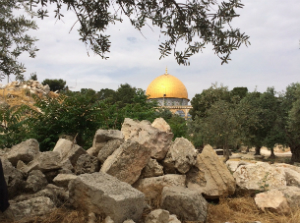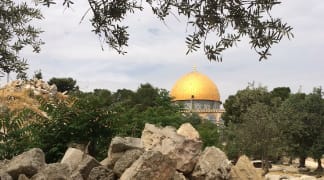This post originally appeared at rabbisblog.brsonline.org/
 In his incredible book The Prime Ministers, Yehudah Avner describes the remarkable circumstances surrounding the capture of the Old City of Jerusalem and the reunification of the eternal capital of the Jewish people:
In his incredible book The Prime Ministers, Yehudah Avner describes the remarkable circumstances surrounding the capture of the Old City of Jerusalem and the reunification of the eternal capital of the Jewish people:
Menachem Begin’s brain was so crammed with thoughts that he could not sleep. Tossing and turning, he was gripped by Jewish memories as old as time. His all-encompassing grasp of Jewish history stirred his deepest convictions, causing him to ponder how much longer Israel could wait before restoring to the bosom of its people Jewry’s most sanctified treasures locked behind the Old City’s walls. Who among his cabinet colleagues, besides Allon, would be brave enough to fight for a motion calling for the immediate storming of the Old City’s walls? At four in the morning he switched on the radio and heard the BBC announcer say that a UN Security Council ceasefire resolution was about to be voted upon with a clear majority. This was the last straw! Instantly, he phoned Eshkol. “What is it?” the prime minister yawned. “Forgive me for disturbing your sleep,” said Begin, “but I’ve just heard the BBC. The Security Council is about to pass a ceasefire resolution. We have no time left. I propose the army be ordered to enter the Old City forthwith, before it is too late.”
“Speak to Dayan,” said Eshkol, his voice suddenly wide awake. “See what he thinks and get back to me.” Begin got hold of Dayan and urged him to agree to a quick cabinet meeting to decide on the storming of the Old City. He did. Again Begin spoke to Eshkol and it was decided the cabinet would convene at seven that morning. It was a quick meeting. By unanimous decision the order was given to immediately penetrate the Old City’s walls, the troops to be spearheaded by a parachute brigade. Some three hours later, after intense combat, the brigade crashed through the Lion Gate, and shortly thereafter came the commander’s message over the wire: “The Temple Mount is in our hands! The Temple Mount is in our hands!”
Just imagine, that now famous statement, “Har Ha’bayit b’yadeinu,” “the Temple Mount is in our hands,” uttered by Motta Gur, commander of the division that captured the Old City of Yerushalayim, might not have been said had Begin slept well that night and a cease fire been called, eliminating the possibility of retaking the Old City and the Temple Mount.
In his book Like Dreamers, Yossi Klein Ha’Levi explains what happened next:
“Motta’s communications officer, Orni, produced an Israeli flag from his pouch. “Should we hang it on top of the Dome? Arik asked Motta. “Yallah,” Motta replied – Go on. Ari and Orni approached the copper doors, intending to hoist the flag onto the crescent moon atop the tome. The entrance was bolted; Arik shot it open with his Uzi.
The men entered the domed silence, boots on thick patterned carpets…Orni and Arik ascended a staircase to the balcony overlooking the sanctuary…Standing on Arik’s shoulders, Orni reached up and fastened the Israeli flag to the Islamic crescent…
Captain Yoram Zamosh reached the Mount. Zamosh was the Mercaz student who had been given an Israeli flag by an elderly woman just before the battle and who had promised to hang it on the Wall.
Motta’s deputy, Moisheleh Stempel-Peles, along with several other paratroopers, was searching for a way down to the Wall and Zamosh joined them. They came upon an old Arab man in a white robe, an official of the Waqf, the Islamic trust in charge of the Mount. He pointed them towards a fenced-off ledge.
The paratroopers stepped onto the ledge. Below them – the Wall. From his ammunition belt, Zamosh extracted the flag and fastened it onto the fence. Then the men sang “Hatikvah,” the national anthem. Zamosh recalled a legend he’d learned as a child: when the Roman legion commanded by Titus burned the Temple, priests threw its keys toward heaven, and a hand reached out and retrieved them for safekeeping. Now, Zamosh thought, the keys had been returned…
Defense Minister Moshe Dayan stood on Mount Scopus and, raising binoculars to his single eye, watched the Temple Mount across the valley… Now, seeing an Israeli flag flying over the Dome of the Rock, Dayan was appalled. He radioed Motta: You’re going to set the whole Middle East on fire. Remove the flag immediately. Motta relayed the order to Arik, who dispatched one of his men: he couldn’t bear to do it himself.
Now, forty-seven years later, as we look back on these miraculous events and reflect on those historic words, Har Ha’bayit b’yadeinu, the Temple Mount is in our hands, we can’t help but wonder, is it really? When Israel gained possession of the Temple Mount, Prime Minister Levi Eshkol wanted to fulfill his dream for this holiest spot. He envisioned a multi-faith council of Jews, Christians and Muslims to control the location and allow all who wished to come and pray to do so. However, his plan never came to fruition.
If, in fact, as the young soldier Zamosh thought, the keys to the Temple Mount had been returned, Moshe Dayan gave them back rather quickly. Just a few days after the Six Day War, Dayan, an Israeli war hero, visited the Muslim Waqf on the Temple Mount. In his autobiography, “Moshe Dayan: Story of My Life” he describes the conversation:
I said that Israeli troops would be removed from the site and stationed outside the compound. The Israeli authorities were responsible for overall security, but we would not interfere in the private affairs of the Moslems responsible for their own sanctuaries. These were two Moslem places of worship, and they had the right to operate them themselves. My hosts no doubt knew that on the day we had captured this site, I had given orders that the Israeli flag be removed from the Mosque of the Dome, where it had been hoisted. We had no intention of controlling Moslem holy places or of interfering in their religious life.
Forty-seven years ago, Moshe Dayan gave the Waqf control of the Temple Mount and they continue to control it today. Just a few weeks ago, I visited Har Ha’Bayit for the third time. When Rabbi Levine, Daniel Katz, David Kay, and I approached the entrance we were told we must submit identification and wait for approval to ascend. As we waited for a good half an hour, we watched as non-Jews and non-observant Jews marched right up without being stopped at all. When we were finally approved, we were cautioned emphatically not to bow, pray or even move our lips in a way that looked like prayer. We were not allowed to bring a Siddur, Tehillim, Tefillin or any religious objects. As we walked the perimeter of the enormous Mount, in addition to an Israeli police officer who seemed more concerned with our not upsetting anyone than with protecting our right to be there, a representative of the Waqf followed us closely looking and listening to all that we did.
Our experience on Har Ha’Bayit was paradoxical, spiritually exhilarating on the one hand, and yet so sad and mournful on the other. Standing on stones from the time of the second Temple, seeing where the Holy of Holies stood, understanding the enormity and magnificence of our Beis Ha’Mikdash, visualizing how the Mount looked on Erev Pesach when the entire Jewish people were bringing their Pesach sacrifices, was simply incredible. Yet, observing the irresponsible excavations that are destroying our ancient artifacts, seeing our holiest site being desecrated, and being deprived of the ability to pray was depressing, tragic, and mournful.
As we walked, we passed groups of women, each of whom stared in our direction and screamed Allah Akbar. As our group paused to look and learn about where we were standing, a man near us took a large metal pipe and continuously dropped it against the stone floor in an effort to disturb and intimidate us, both of which he accomplished successfully. In a small gesture of defiance, we continuously prayed in our hearts and when we paused opposite the Kodesh Ha’Kadashim, the Holy of Holies, we even had Daniel Katz, a Kohen, give us the Priestly Blessing.
As we descended the Mount, I kept thinking to myself, it sure doesn’t feel like Har Ha’Bayit b’yadeinu. Did Moshe Dayan make a historic mistake or were we simply not ready? Are we ready now? Do we really care about Har Ha’Bayit and do we truly yearn to have the right to pray there?
Less than a year ago, a survey was done in Israel to measure public opinion on the importance of the Temple Mount. Only 29% of the people asked thought that Har Ha’Bayit is the holiest place for the Jewish people, with 66% believing it is the Kotel. Forty percent said that it is not important to them that Jews visit the Temple Mount. Forty-one percent have no interest in a tour of Har Ha’Bayit. The survey was conducted randomly, but I imagine that if these same questions were asked of observant Jews, the responses wouldn’t be that different.
Despite being pervasive in our prayers and occupying so much of our tradition, the average Torah Jew, unfortunately, does not think often about Har Ha’Bayit or what we can do to gain the right to pray there. Granted, ascending the Mount is not for everyone. There are legitimate halachik concerns and not all authorities allow it. Those that do ascend need to first go to the mikvah with full preparations, not wear leather shoes, not carry any bag and maintain the seriousness and sobriety that our holiest place demands.
There are legitimate reasons not to go on Har Ha’Bayit but there is no excuse not to think about, care about, and advocate for the right for Jews to pray on Har Ha’Bayit. No matter what has happened in our history, we have not forgotten the Temple Mount. R’ Menachem Meiri in the 13th century references those that ascend Har Ha’Bayit. Rabbeinu Nissim, the great 14th century Spanish halachist, explicitly acknowledges the custom yet in his time of aliyah l’regel, visiting Har Ha’Bayit. In the 15th century, the Radbaz wrote that his peers regularly visited the Temple Mount to pray there and, “we have not heard or seen anyone object to this.”
Maybe we are finally ready to take back the keys. This week, Labor Party Knesset member Yehiel Bar joined Likud Knesset member Miri Regev in sponsoring a bill that would grant freedom of movement, religion, and worship on the Temple Mount to all religions. However, immediately, the Jordanians, Arab Knesset members, and even the Shin Bet who fear it could spark riots, placed significant pressure to withdraw the bill.
Importantly, nobody is suggesting doing anything to the Dome of the Rock or the Mosque on Har Ha’Bayit. No one is advocating preventing Muslims from practicing and praying. The bill only seeks equal access and rights for all religions, just as Prime Minister Eshkol originally wanted.
Will it pass? Will we get the keys back to our people’s holiest place taking us one step closer to the final redemption? I don’t know. What I do know is meriting Har Ha’Bayit begins with caring about it. As we celebrate Yom Yerushalayim this week and the forty-seventh anniversary of the reunification of our holy city, the eternal capital of the Jewish people, please keep Har Ha’Bayit close to your hearts and prayers.
May we merit the day to ascend together as we visit the third Beis Ha’Mikdash speedily in our day.
The words of this author reflect his/her own opinions and do not necessarily represent the official position of the Orthodox Union.
